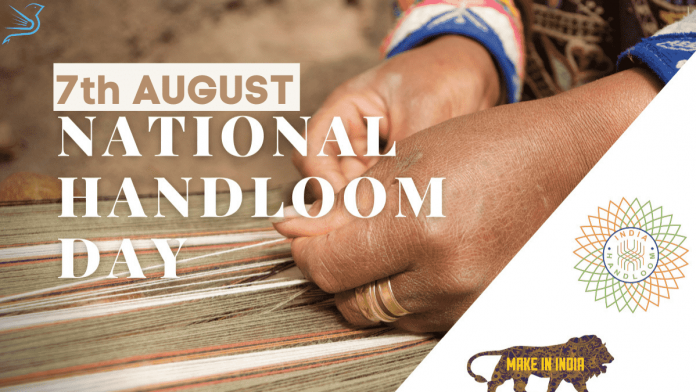7th August is celebrated every year to honour the handloom weavers of our country and it also highlights India’s handloom industry.
BACKGROUND
It is celebrated every year to commemorate the Swadeshi Movement that was launched on the same day in the year 1905. In the year 2015 the government declared 7th august as National Handloom Day with the objective of making people aware about the importance of the handloom industry in the socio economic country. To protect our handloom industry and pay honour to our handloom weavers for their resilient art it is therefore of great importance.
7th august 2015
On August 7, 2015, Prime Minister Narendra Modi had inaugurated the primary National Handloom Day on the College of Madras’ Centenary Corridor in Chennai. The Authorities had declared August 7 because the National Handloom Day since then with the target of producing consciousness concerning the significance of the handloom trade. The primary purpose of this is to highlight how the handloom industry socially and economically helps our country.
As we now know the crux of the story lets us learn about handloom and its significance in India and the world.
What is HANDLOOM?
As the name suggests, it is a loom which is used to weave fabric using hands and not machine or electricity and that is the reason why it is of significant importance.
As a matter of fact, around 95% of the world’s handloom comes from India and therefore it is of great importance that we protect and save this industry from vanishing its persona.
Hand weaving is performed on pit looms or frame looms which are usually located in the homes of the weavers. Yarn spun by hand is called ‘hand spun yarn’ and yarn spun by machine is called ‘mill spun yarn’. Fabrics woven from hand spun yarn on handloom are called ‘khadi’, while mill spun yarn woven on handloom is called ‘handloom fabric’.
Benefits of Handloom
- Hand woven clothes for example cotton provides breathability and therefore makes us feel cooler.
- It contributes to India’s GDP
- Provides employment to many people both living in urban or rural areas.
- Production of handlooms in our country is the world’s largest.
- It also contributes 15% to the clothing sector.
Popular handloom fabrics across India
- Kanjeevaram – Tamil Nadu – The Kanjeevaram sarees are the most popular handloom products. It takes around 6 to 7 months to be made and is usually worn on special occasions.
- Ikat Art – It is more concentrated in Odisha/ Orissa.
- Kalamkaari – Andhra Pradesh – It is mainly famous for its block and hand painted designs. It is the oldest form and flourished during the times of Mughals.
- Banarasi – Uttar Pradesh – Quite famous Banarasi sarees are liked highly by Indian women.
- Bandhani and Patan Patola – Gujarat
- Bhagalpuri Silk – Bihar – Finest silk of the country. Made from Tussar cocoon.
Quote – The Revival Of Handspinning And Hand Weaving Will Make The Largest Contribution To The Economic And The Moral Regeneration Of India ~ Mahatma Gandhi
As you must have seen how culturally, socially and economically important the handloom industry is, it is very important that we save it and protect its dying culture. Apart from that, it continues to be an important source of livelihood, especially for women, who form around 70% of the weavers or allied workers in the sector.
National Handloom Day!
Thank you!




